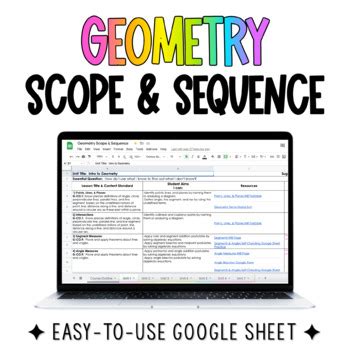Introduction
Geometry, a fundamental branch of mathematics, plays a vital role in developing spatial reasoning, problem-solving skills, and logical thinking. The high school geometry curriculum provides a comprehensive framework for students to explore the concepts, theorems, and applications of geometry. This scope and sequence outlines the key topics and learning objectives for each unit, empowering students to gain a deep understanding of geometric principles.

Unit 1: Basic Concepts and Properties of Plane Figures
- Objectives:
- Define and classify polygons (e.g., triangles, quadrilaterals, circles).
- Explore geometric shapes and their properties (e.g., perimeter, area, volume).
- Develop an understanding of angles, their measurement, and their relationships (e.g., angle bisectors, perpendicular bisectors).
Unit 2: Transformations
- Objectives:
- Learn about translations, rotations, reflections, and dilations.
- Understand the concept of congruence and similarity.
- Apply transformations to solve problems involving shapes and patterns.
Unit 3: Triangle Congruence and Similarity
- Objectives:
- Prove congruent triangles using different criteria (e.g., SSS, SAS, ASA).
- Identify similar triangles and demonstrate their properties (e.g., proportional sides, corresponding angles).
- Solve problems involving triangle congruency and similarity.
Unit 4: Quadrilaterals and Trapezoids
- Objectives:
- Classify and identify quadrilaterals (e.g., squares, rectangles, parallelograms, trapezoids).
- Explore the relationships between angles, sides, and diagonals in quadrilaterals.
- Solve problems involving the properties and area of trapezoids.
Unit 5: Circles
- Objectives:
- Define and understand the key elements of a circle (e.g., radius, diameter, chord).
- Determine the circumference and area of circles.
- Explore the properties of secants, tangents, and arcs.
Unit 6: Three-Dimensional Geometry
- Objectives:
- Identify and classify three-dimensional shapes (e.g., cubes, cones, cylinders).
- Understand the concepts of surface area and volume.
- Solve problems involving the properties and measurements of three-dimensional figures.
Unit 7: Coordinate Geometry
- Objectives:
- Plot and graph points in the Cartesian coordinate plane.
- Write equations for lines, circles, and other geometric shapes.
- Analyze and interpret geometric relationships using coordinate geometry.
Unit 8: Applications of Geometry
- Objectives:
- Apply geometric principles to real-world problems and applications.
- Explore the connections between geometry and other disciplines (e.g., physics, engineering).
- Develop an appreciation for the practical value of geometry in various fields.
Assessment and Evaluation
Assessment of student understanding is an integral part of the geometry curriculum. Teachers employ various assessment methods such as:
- Quizzes and tests
- Projects and presentations
- Homework assignments
- Classroom participation
- Performance tasks
Common Mistakes to Avoid
- Rushing through concepts: Geometry requires a deep understanding of fundamental concepts. Avoid skipping steps or attempting advanced topics without a solid foundation.
- Memorizing formulas: While formulas are important, focus on comprehending the underlying geometric principles. Understanding the concepts will make formulas more meaningful and easier to recall.
- Neglecting proofs: Proofs are essential in developing logical thinking and problem-solving skills. Dedicate ample time to constructing and analyzing proofs.
- Ignoring visual representations: Geometry is a visual subject. Use diagrams, sketches, and manipulatives to visualize concepts and solidify your understanding.
Engaging Students in Geometry
- Make connections: Relate geometric concepts to real-world applications and everyday experiences.
- Use manipulatives: Hands-on activities with manipulatives (e.g., blocks, protractors) can enhance understanding and make learning more engaging.
- Incorporate technology: Utilize interactive software, simulations, and online resources to supplement lessons and cater to diverse learning styles.
- Encourage collaboration: Create opportunities for students to work in pairs or small groups to solve problems and share ideas.
- Provide differentiated instruction: Tailor instruction to meet the needs of individual students, providing additional support or enrichment as required.
Conclusion
The high school geometry scope and sequence provides a roadmap for students to systematically explore geometric concepts and develop a solid foundation in this essential field. Through engaging activities, problem-solving exercises, and real-world applications, students can cultivate their geometric intuition, spatial reasoning, and critical thinking abilities. By embracing these principles and fostering student engagement, educators can empower students to succeed in geometry and beyond.
